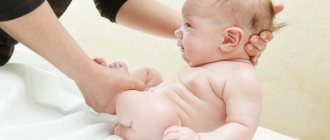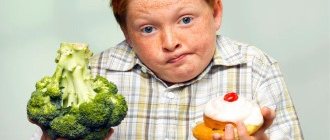Author, editor and medical expert - Klimovich Elina Valerievna.
Number of views: 486 530
Last updated: 02/16/2022
Average reading time: 17 minutes
- Therapeutic diet
Constipation (from the Latin constipatio - accumulation, accumulation) can occur in a child at any age1, 3. It is associated with a slowdown in the movement of feces through the intestines3, 4. This is one of the most common “children’s” problems4, but many parents do not recognize it or They believe that a child at 3 or 4 years old will “go away on its own”, without medical help. Some parents do not consult a doctor on time3, 5 because they cannot understand whether the baby goes to the toilet often enough, whether the density and volume of feces is normal1, 3, 5.
Up to contents
Causes of constipation in infants and children under 7 years of age
Due to the anatomical and physiological imperfections of the digestive system and the influence of numerous risk factors, a single cause of the disease has not been established. Constipation in a child is a complex, polyetiological disease that has individual mechanisms of development and manifestation. The impact of risk factors and a number of other circumstances lead to a slowdown in the propulsive activity of the intestine, the accumulation of dense masses in the distal sections, and the appearance of characteristic symptoms of the pathology.
Main predisposing factors
| Prenatal | Intrapartum | Postnatal |
|
|
|
Dominant causes of constipation
Nutritional reasons
These include the following factors:
- nutritional disorders and indiscriminate feeding;
- underestimation of the baby’s individual food preferences, frequent changes of formulas;
- forced and excessive feeding (“to the last drop”);
- introducing into the diet foods that a child of this age cannot adequately digest;
- early introduction of complementary foods and transition to solid foods;
- selective nutrition (deficiency of dietary fiber, imbalance between food ingredients);
- disordered eating pattern (disordered and episodic eating).
Social and psychological reasons
These include the following factors:
- low physical activity, tight swaddling, use of diapers with tight straps, etc.;
- “potty phobia” syndrome;
- pedagogical errors in education;
- psychological depression, increased shyness;
- unformed stereotype of defecation;
- low stress resistance and lability of the child’s character.
Pathological conditions of the body
This includes the following:
- organic intestinal diseases (Hirschsprung's disease, dolichocolon and dolichosigma (elongation of intestinal sections), anal fissures, hemorrhoids;
- iron deficiency;
- rickets;
- neurological diseases (myopathies, paresis, paralysis of various origins);
- in girls, inflammatory processes of the internal genital organs;
- endocrine and metabolic diseases (diabetes mellitus, hypothyroidism, cystic fibrosis).
Use of certain groups of medications
These include:
- codeine and its derivatives;
- sedatives (phenobarbital, antidepressants, phenothiazine derivatives);
- Loperamide;
- enterosorbents;
- antacids, etc.
Types of constipation
Spicy
This type is temporary. Constipation in a child occurs infrequently and lasts only a few days.
It can be caused by changes in diet or daily routine, travel, lack of exercise, illness or medication.
You can relieve your child's severe constipation with over-the-counter laxatives, exercise, or a high-fiber diet.
Chronic
Constipation in children lasts more than three months, and sometimes continues for many years. The disorder disrupts the child's daily life. It does not go away without changing diet and physical activity, and requires the use of medications prescribed by a doctor.
Functional
Functional (idiopathic) constipation implies that there is no identifiable causative organic condition.
This type of disorder usually begins after the neonatal period. There is almost always a deliberate or subconscious retention of the stool. The acute form often precedes the chronic course. The stool becomes hard, smaller in volume and difficult to pass, which leads to irritation in the anus and the appearance of cracks.
In children under 3 years of age, forced or too early potty training may initiate bowel retention. In older children, persistent constipation may develop when the child is in a situation that does not allow bowel movements, such as at school.
As the act of defecation becomes painful, voluntary retention of feces occurs to avoid pain. Then the urge to defecate disappears, since the rectum contains all the contents. This vicious cycle gradually gets worse as the volume of stool that needs to be eliminated increases.
Suppositories with glycerin
Suppositories with glycerin have an irritating effect on the rectal mucosa.
Glycerin suppositories are an emergency remedy. In appearance, these are smooth, oily suppositories. The main substance has an irritating effect on the rectal mucosa.
The drug is prescribed when the use of oral medications does not bring relief or when it is impossible to take drops or tablets.
For toddlers under 2 years of age, suppositories are prescribed only in exceptional cases. Suppositories are inserted into the anus once a day. After administration, you should wait 5 to 15 minutes. Residues of the drug are excreted along with feces. The duration of use of this laxative should not exceed 1 week.
Side effects - pain, burning at the injection site, nausea, flatulence. In case of an overdose, diarrhea and frequent, but ineffective, urge to defecate may occur.
Main manifestations
In infants with delayed bowel movements, visible changes are minimal. With prolonged intestinal dysfunction, it is possible to detect an increase in the size of the abdomen due to the accumulation of feces in the distal parts of the gastrointestinal tract. Children complain of a feeling of awkwardness, fullness and distension in the abdomen, especially on the left side.
When dense and fused fecal masses are expelled, the patient experiences sharp pain in the anal area, which is caused by the appearance of tears and cracks. The child subsequently does not dare to defecate, accompanied by painful sensations, begins to spontaneously delay bowel movements, resulting in prolonged constipation, and sometimes the reflex to defecate is lost.
Diagnostics
Diagnosis is carried out in two stages.
First stage
At the first stage, the doctor carefully collects and analyzes the medical history, clarifies the factors and somatic disorders that contribute to the formation of the disease, and conducts a physical examination.
History taking
A history can often help differentiate functional constipation from Hirschsprung's disease.
It is especially important to find out when the baby first had stool after birth. Most babies with Hirschsprung's disease experience constipation immediately or shortly after birth. More than half of infants with this pathology do not have meconium (original feces) in the first 36 hours of life.
The doctor should also ask questions about the child's specific symptoms of constipation, their onset and duration, and whether there is pain or bleeding associated with bowel movements.
In infants, functional constipation often develops due to dietary changes (eg, changing breast milk to formula, adding solid foods to the menu, replacing formula with whole milk).
In children under 3 years of age, idiopathic constipation occurs during potty training. In a child of early and preschool age, stool retention may develop after diaper dermatitis or dehydration.
It is not uncommon for older children to develop functional constipation when they start school because they refuse to have a bowel movement while they are at school.
Physical examination
The most important part of the physical examination is the rectal examination. A doctor should do this for any child with chronic constipation, regardless of age, to rule out underlying anatomical abnormalities that may be causing constipation, such as:
- anal atresia (closure of the opening) and urethroperineal fistula (hollow canal in the skin of the perineum);
- intestinal obstruction (fecal blockage effect);
- Hirschsprung's disease.
You should also pay attention to the size of the anal canal, the size of the rectum and the presence of any intrarectal masses. If the rectum is filled with stool, its consistency should be noted.
Among children with Hirschsprung's disease, the rectum is usually quite small and empty. After the examination, the infant may have loose stools because the functional obstruction has been temporarily relieved.
In a child with functional constipation, the rectum is usually enlarged and stool is present only behind the anal verge.
It is important to confirm the presence of the anal (skin) reflex. To cause it, the doctor will stroke the skin on the perineum with a pin. The external anal sphincter will contract in response to stroking. The absence of this reflex may indicate an abnormality with the peripheral sensory or motor nerves, or the central connections mediating the reflex.
Second phase
The second stage of the examination is instrumental. It is initiated if the prescribed therapy has not had a sufficient effect, the clinical picture persists, and the doctor doubts the functional nature of the pathology, suspecting the presence of anomalies of the distal gastrointestinal tract, Hirschsprung's disease. Sigmoidoscopy or colonoscopy and irrigography are used.
Roman criteria
According to the Rome II criteria, functional constipation is diagnosed if the patient has at least two of the following manifestations:
- absence of defecation for at least 25% of normal bowel movements;
- constipation continues for at least a year without using laxatives;
- need for excessive straining;
- stool is lumpy or hard;
- a feeling of incomplete emptying (this criterion cannot be applied to infants and young children);
- less than two bowel movements per week.
If there is only irregular bowel movement, and the listed criteria for constipation are absent, functional stool retention is diagnosed.
In infants, in most cases, functional stool retention is observed, and in early childhood, functional constipation is more often observed.
Consequences
Constant constipation causes chronic fatigue, weakness and loss of appetite. This is due to digestive disorders, intoxication, as well as active absorption of harmful components from stagnant feces. With constipation, peristalsis slows down and feces are retained. All this causes a change in the bacterial microflora of the intestine.
Pathogenic microflora begins to actively develop and release toxic substances. The accumulation of feces causes disturbances in the trophism of the intestinal mucosa. Chronic stool retention entails dysbiosis, in which the level of beneficial microorganisms decreases, while pathogens begin to become more active. This also affects the absorption of vitamins and microelements.
All this shapes the development of vitamin deficiency and anemia. Often, against the background of dysbacteriosis, inflammatory processes begin to develop. Feces stretch the intestinal walls, causing inflammation of the mucous membrane, increased gas formation, spastic pain, and impaired local circulation.
Severe constipation causes cracks in the rectum, bleeding from the anus, as well as pain that can lead to the development of neurological problems. Toxic substances from the intestines begin to be absorbed into the blood. Children with chronic constipation look weak, pale, and lethargic. The child sleeps poorly, loses weight, and becomes capricious.
How to help a child with constipation
Treatment of constipation in children is a rather complex and lengthy task.
Changing your diet
Dietary changes, such as increasing fluid and carbohydrate intake, are usually recommended as part of the treatment for constipation.
Balanced diet
Poorly absorbed sugars (eg sorbitol) are found in many fruit juices (eg prune, pear, apple). These sugars increase the frequency of bowel movements. If your child is constipated, it is recommended to eat a balanced diet that includes whole grains, fruits, vegetables and plenty of fluids.
Elimination of cow's milk
Cow's milk protein should be eliminated from the diet of infants and young children for a period of time as it aggravates chronic constipation.
Unnecessary or ineffective dietary changes
There is no need to switch your baby to low-iron formula. Several studies have shown that consuming iron-rich formulas is not associated with constipation.
There is also no reliable evidence that the use of probiotics is effective in treating constipation in adults and children.
Increased physical activity
For adults and children, daily exercise will help with digestion and relieve constipation.
Regular physical activity helps food move quickly through the colon and helps the intestinal muscles contract, moving waste around.
On the other hand, inactivity leads to weak bowels, making it difficult to pass feces regularly.
One of the best exercises for children is walking. Take 30 minutes a day to walk, especially after meals.
Swimming and cycling on a regular basis will also be beneficial.
Drug therapy. The main groups of drugs for the treatment of constipation in children
The mainstay of pharmacological therapy for constipation is the use of sufficient laxatives to achieve the desired effect. Continuous use of laxatives may be necessary for several months until the association between bowel movements and pain disappears.
Osmotic laxatives:
- polyethylene glycol;
- magnesium hydroxide;
- lactulose;
- sorbitol;
- magnesium citrate;
- sodium phosphate.
The drugs help attract water from the cells, which leads to expansion of the intestines and increased peristalsis.
Laxatives with a stimulating effect:
- Sennoside;
- Bisacodyl.
Drugs in this group enhance peristaltic activity in the gastrointestinal tract. Most of these agents also stimulate the release of salt and water in the colon.
Stool softeners:
- docusate sodium.
The drug saturates the stool with water and fat, helping to soften it.
ethnoscience
Early research suggests that drinking herbal teas made from fennel, anise, elderberry and senna daily for 5 days may reduce constipation.
Fennel seeds stimulate muscle movement in the digestive tract, which leads to healthy digestion and regular bowel movements. Fennel seeds also prevent gas in children.
The use of a cleansing enema for constipation in children
In some cases, an enema can be used to help relieve constipation.
However, this should only be done on the advice of a doctor. This method should not be used constantly, since regular use of an enema can prevent the intestinal muscles from properly doing their job of removing feces.
It is also possible to develop an electrolyte imbalance, which will require additional treatment.
Folk remedies
Proven traditional medicine recipes will help you cope with constipation and restore normal bowel function:
- Wheat bran and seaweed are natural laxatives. They can be added to food or consumed separately with water. In the intestines they swell, increasing the volume of feces, diluting, and also accelerating the evacuation process;
- infusions of senna leaves. For a glass of water you need to take a tablespoon of raw material. The product should be brewed in the evening and filtered in the morning. The child should be given a tablespoon of infusion three times a day;
- rosehip juice and leaves. Populists advise grinding rosehip leaves with sugar, and pouring spring water into the squeezed juice;
- tea made from dried apples and cherries;
- cabbage brine has a pronounced laxative effect;
- Give your child oatmeal jelly or plum broth several times a day.
When constipation threatens the patient's life
Constipation in itself is not fatal. But with prolonged retention of stool, certain changes can occur that cause death.
Studies have shown that patients with constipation are at risk of developing cancer. The human digestive tract passes through thousands of carcinogens.
With irregular bowel movements, these chemical compounds are retained in the body, which leads to the appearance of atypical cells. In patients with constipation, tumors are more often found in places where feces accumulate - the splenic and hepatic angle, the sigmoid and cecum.
Preventing constipation in a child
- Children should be offered foods high in fiber, such as fruits, vegetables, beans, whole grain cereals and breads. If your child is not used to a high fiber diet, you can start by adding a few grams of fiber to their food daily to help prevent gas and bloating.
- The child should be encouraged to drink plenty of fluids.
- Regular physical activity stimulates intestinal motility.
- Going to the toilet should be comfortable for the child. You can provide your baby with a footstool so that he has enough support to have a comfortable bowel movement.
- It is important to remind your child to never ignore the urge to defecate.
Gymnastics
To prevent the pathological condition, walking and running, swimming, exercises to strengthen the abdominal press, squats, and bends are useful.
It is believed that mobile, active children suffer less from constipation. To prevent the pathological condition, walking and running, swimming, exercises to strengthen the abdominal press, squats, and bends are useful.
If your child is already suffering from bowel problems, it is recommended to start the day with simple morning exercises. Massage may also be helpful.
It is important to pay attention to the general change in the baby’s behavior.
The child should be taught to go to the toilet at approximately the same time and encouraged for following the daily routine (motivated and praised).
It is also important to create a favorable environment in the toilet. Nothing should distract the child from the act of defecation or frighten him in the bathroom.








